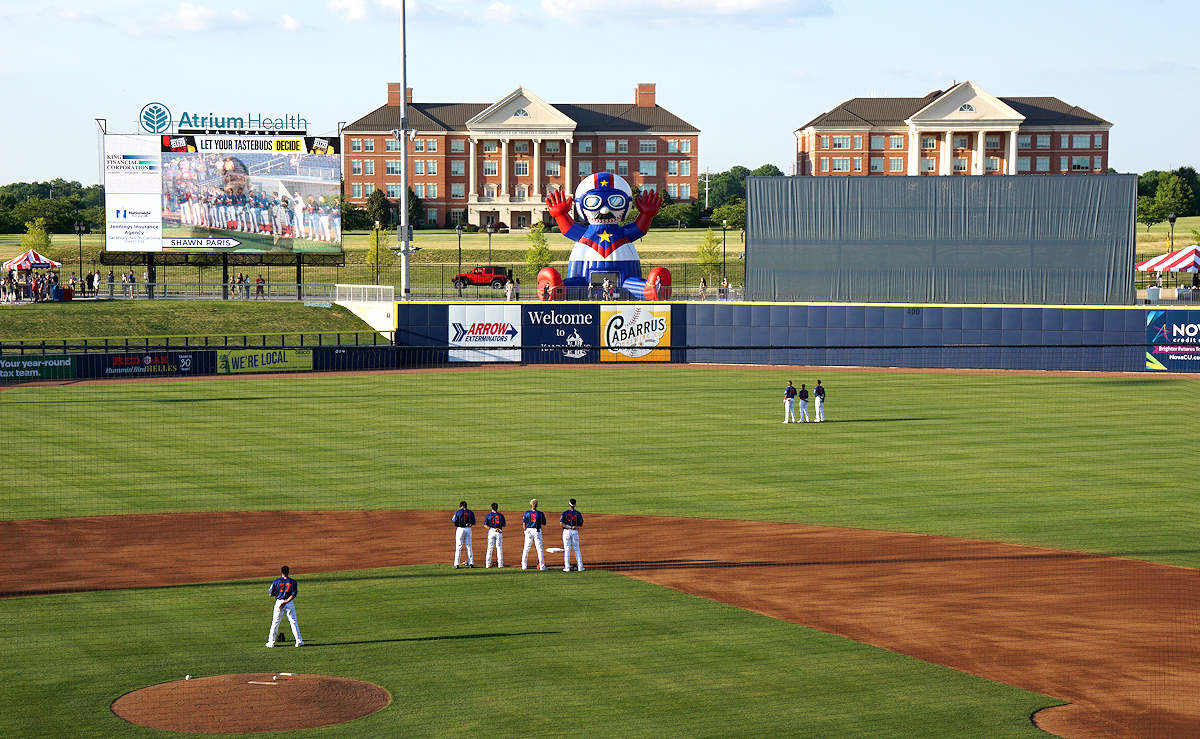
Article and all photos by Joe Mock, BaseballParks.com
All rights reserved
KANNAPOLIS, North Carolina Many times a city has the will and the funds to build a new ballpark, but there’s no team to be the tenant.
| Ballpark Stats |
 |
| Team: Kannapolis Cannon Ballers of the Low-A East League |
| First game: May 5, 2021, an 8-4 loss to Down East |
| Capacity: 4,930, of which 3,500 are permanent seats |
| Dimensions: LF – 325; LCF – 374; CF – 400; RCF – 384; RF – 315 |
| Architect: Populous — Jason Michael Ford, Project Manager; Zach Allee, Project Designer |
| Construction: Barton Malow |
| Price: $52 million |
| Home dugout: 1B side |
| Field points: Northeast |
| Playing surface: Latitude 36 Bermuda |
| Naming rights: Atrium Health for 10 years |
| Ticket info: milb.com/kannapolis/tickets/ |
| Betcha didn’t know: The ballpark was built on the site of the old Cannon Fieldcrest textile mills. |
On the Major League level, this happened in St. Petersburg. Starting in 1990, the city tried to lure first the White Sox, then the Giants, Twins and Mariners to the already-built Suncoast Dome (today called Tropicana Field). One by one, all of these teams were able to leverage St. Pete’s interest into new stadiums in their current city. It wasn’t until MLB granted an expansion team to the Tampa Bay Area in 1998 that the stadium obtained the baseball tenant they had long desired.
Then there is the opposite scenario. You have a team, but a new park is needed. And in Kannapolis, North Carolina, they also needed a new owner for the franchise they already had.
Kannapolis had a South Atlantic League team playing in Intimidators Stadium, which opened in 1995. While it wasn’t hopelessly obsolete, it was located way out on the edge of town, nowhere close to any other businesses — nor would there ever be development near the park, because it was in an environmental zone that prohibited it. Fans drove there, parked in the lot adjacent to the ballpark, watched baseball, got in their cars after the game, and went home. There was no reason to come early or stay late.
City leaders had a very different plan. They wanted a ballpark that could attract development around it, that could bring people to the center of town for some shopping and dinner before a game, or a drink afterwards. Or to give residents of newly built apartments or condos nearby something to do. The city had the team, but they needed a new place for them to play.
The story behind Atrium Health Ballpark, though, starts way, way before even Intimidators Stadium was built. And the original name of the Intimidators’ ballpark holds a huge clue: Fieldcrest Cannon Stadium.
Eddie Smith is the Deputy City Manager of Kannapolis, and he helped us understand the history of the area. It’s amazing that the city wasn’t incorporated until 1984, because this spot on the map was a powerhouse of American manufacturing, all due to the textile industry. In fact, prior to 1984, the mill more or less operated the town.
Back in 1906, J.W. Cannon bought land to construct Cannon Mills. Soon there was seven-million square feet of textile operations here, making it the largest such plant in the world. Most of the sheets purchased in America were made here.
Over the decades, foreign competition eroded Cannon’s market share. In 1982, the principal owner of Dole Food Company, David Murdock, purchased 98% of Cannon Mill’s stock. He then spent another $200 million in improvements to modernize to the mills. Two years after Kannapolis’ incorporation in 1984, Fieldcrest bought the factory (but not the surrounding land) from Murdock for $250 million. They changed the operation’s name to Fieldcrest Cannon — hence the name Fieldcrest Cannon Stadium when Minor League baseball came to town in 1995.
Through the 2000 season, the team was known as the Piedmont Boll Weevils. NASCAR legend Dale Earnhardt (Senior, not Junior), who was born in Kannapolis in 1951, then became a part owner of the franchise, so the team adopted Earnhardt’s nickname and became the Kannapolis Intimidators. Interestingly, unlike virtually every other pro franchise, the team didn’t own the rights to its own nickname, because Earnhardt retained the rights to the term “Intimidator.” This prevented the team from being able to capitalize fully on lucrative merchandise sales, which one has to figure was popular with NASCAR fans.
| The Cannon |
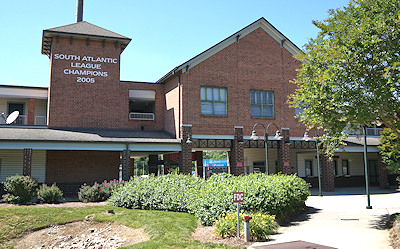 |
| Even though the former ballpark stopped being called Cannon Fieldcrest Stadium in 2012, many locals continued to refer to it as The Cannon. When baseball ceased here in 2019, the upkeep stopped, too. This is what the old park looked like as Atrium Health Ballpark started hosting games downtown. |
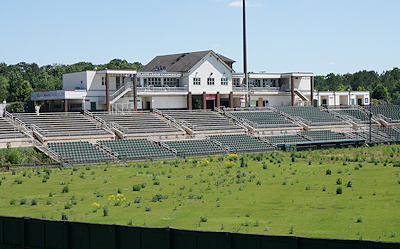 |
Before Earnhardt could see his hometown team play a game using their new nickname, he was killed at the 2001 Daytona 500. A public memorial service was held at the packed ballpark.
Meanwhile, a company called Pillowtex had purchased the mills in 1997 for $700 million. With cheap goods from overseas eating the lunch of the American textile industry, the mills here declared bankruptcy and closed for good six years later. While 4,300 mill jobs were lost, another 15,000 locals lost work due to the shutdown. This is considered to be single largest job loss in North Carolina history.
The story gets really interesting here. In 2005, Murdock, the same person who bought the mills in 1982 and sold the central factory to Fieldcrest four years later, swooped in to purchase the property he didn’t already own. He quickly had the buildings there demolished — starting just two months after the Intimidators had won their only South Atlantic League championship — because he had big plans for the land.
You see, Murdock’s beloved mother had died of cancer at age 42, and his wife Gabriele, the mother of his children, was struck down the same way. Murdock became a zealot in the cause of researching and curing cancer. And his ownership of Dole had convinced him that fruits and vegetables could be key components in the war on this dread disease.
On the land where millions of yards of textiles had once been produced, he spearheaded the creation and construction of the North Carolina Research Campus. Today, eight universities, all from North Carolina, have major research facilities here. Two of their beautiful buildings can be seen in the background of the photo at the top of this page.
And in the exact location of Plant Building #1 of the mills now sits the Core Building, which houses research on how fruits and vegetables can combat obesity, diabetes, brain disease and more. It is in this facility where applications are developed to utilize the research conducted in the other buildings of this campus. Over the past decade, incredibly worthwhile research entities have established labs here, addressing everything from multiple sclerosis to agriculture methods. Through it all, Murdock continued to own the land where all of this incredible work was happening. Plus he owned eight blocks in the center of Kannapolis.
Don’t worry. We’re getting to how a ballpark arose here.
In 2014, a study was conducted by the city and Duke Energy. “We wanted to see how we could best benefit from the presence of the Research Campus,” explains Smith. “The study concluded that the Campus was great, but the city was dead. There was nothing here that would attract people to want to live here.” The city decided that a major initiative was needed to “jump start” development in the city’s core, and part of that needed to be significantly more housing, because residences near the Campus were severely lacking.
| The Deputy |
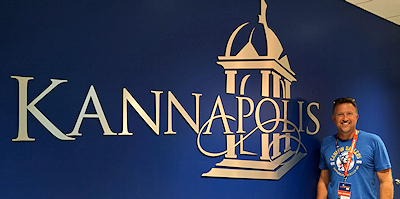 |
| Eddie Smith is the Deputy City Manager for Kannapolis. He provided our history lesson on how textiles were everything to the community for a century, and how the city made a $100-million-plus investment in their downtown after the mills shut down. |
In 2015, Kannapolis kicked things into high gear. City leaders flew to Los Angeles to meet with Murdock, who was then 92 years old. They asked him to sell the 54 acres closest to the center of town to the city so they could create a new downtown of homes, shops, restaurants and more. “Murdock listened to all of our plans,” says Smith. “He then told us that our downtown wasn’t for sale, but he loved our vision and would help us.” An arrangement was reached where the city spent $9 million buying old buildings on the land, so they had control of the site for their desired new development. Further, Murdock donated the acreage needed to build a new structure to house City Hall, police headquarters and a first-class meeting venue called the Laureate Center. Today this gorgeous structure, built at a cost of $32 million, is on the same looping street as the University of North Carolina Nutrition Research Institute and the Plants for Human Health Institute. These are the two beautiful buildings you see in the background of the photo at the top of this page.
But Kannapolis still had the problem that the Duke Energy study declared that downtown was dead. City leaders knew they needed a “people attractor” to bring people downtown, so they commissioned another study. It looked at 30 cities that had Class-A Minor League teams, and it was determined that Kannapolis ranked second in projected growth in the coming five years, and fourth in entertainment spending.
Rich Neumann, a consultant with Brailsford & Dunlavey, worked with the city on what actions to take based on the study’s findings. “We considered three options as people attractors,” says Smith. “We looked at a children’s museum, a performing arts center and a new ballpark. With Rich, we realized that clearly the ballpark was the one that would generate (investment) money. He said that with every dollar of public money spent on a stadium, there would be a return of four dollars in private investment. And we saw that to be true almost immediately, because as soon as we committed the funds to build a stadium, LMG announced a $60 million apartment complex would be built nearby.”
Smith is quick to give the credit for this solution to Neumann. “Rich is the single human being who made all of this happen because he convinced our city council that it was the right thing to do.”
In 2016, city officials hired national construction company Barton Malow to oversee the building of the ballpark and the infrastructure for the four-block area along West Avenue. Shortly thereafter, an RFP was issued by the city to select the architect for the park, and international sports-facility heavyweight Populous was chosen. Based on the input from Barton Malow and Populous, Kannapolis committed $52 million to build the stadium, and another $30 million to re-do the four blocks, just beyond right field of the proposed ballpark site.
When you add together the funds committed to buying old buildings, constructing a ballpark, re-doing what’s along a downtown street plus building a $14-million parking deck, you’re well over $100 million. How can a city with a population of only 51,000 possibly afford that?
“We have a fantastic management team here,” explains Smith. “We showed the city council that our growth will handle the debt service.” Adds Neumann, “Rarely do you see officials in a city be in lockstep, all being behind a project. The way Kannapolis did this serves as the prototype for how this can be accomplished.”
With the funds committed, planning work began in earnest. The official groundbreaking was held October 30, 2018. The partnership between Barton Malow, Populous, the Intimidators and the city worked really well. “The relationships that developed were tremendous,” says Smith. “Everyone was really on the same page.”
Meanwhile, there were issues with Intimidators ownership, and with the commitment by the city to build a new ballpark, such a hiccup couldn’t be left to fester. Neumann’s longstanding relationships in Minor League Baseball helped in this regard. Enter Andy Sandler, Chairman and CEO of Temerity Capital Partners. He’d never owned a baseball team, but he loves the sport, having played it well into his 50s on Men’s Senior Baseball teams. Members of Sandler’s family are his closest advisors on business matters.
“I met with my sons when we had this opportunity to buy the team,” Sandler told us. “One of my sons said that the economic investment in the team won’t give us the return that our other investments do, but we will kill you if you don’t do this because we know how much you must want to do this.
“From that moment, we were all in.”
| Running the team |
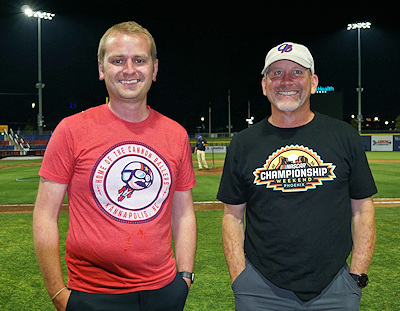 |
| In the front office, Temerity Baseball named Matt Millward (left) as the GM and Scotty Brown as the Operating Partner. Millward has worked with the Lehigh Valley IronPigs and Charlotte Knights. Brown has a three-decade career including stints with the Orioles, Mets and most recently as GM in Charlotte. |
The new ballpark project was well underway when Sandler took the reigns of the team, but he quickly partnered with the city to bring the park across the finish line. He was highly motivated because, he says, “This was a city rising from the ashes of the mill closing.”
While the team didn’t want to turn its back on its NASCAR heritage in general and the beloved memory of native son Dale Earnhardt in particular, they needed to be able to control their own team nickname. Moving into the new park was the best time to re-brand. Despite displeasure from many locals who didn’t want to discard the Intimidators name, the team announced the impending change and solicited suggestions from fans. More than a thousand were submitted.
The new moniker was announced at an event called The Big Reveal. Held at the gorgeous Gem Theatre less than a block from the ballpark’s right-field wall, all 900 seats were filled, while thousands more stood outside the theater watching on TV monitors. The team produced an incredible 20-minute video that told the story of baseball in the area, and finished by revealing that the team would henceforth be called the Kannapolis Cannon Ballers. You can watch that video here.
Not only does the nickname have a definite ring to it, it also harkens back to the Cannon Mills. And, of course, a “baller” is someone who is good at his sport. The new name was a hit.
The new logo was as important as the team name. Sandler says he wanted “to continue to honor Dale Earnhardt. We just couldn’t use the Intimidators name because we could not control how we used it. Boomer Baller, the (new) mascot, very intentionally has Dale’s mustache and racing helmet to honor Dale and the Kannapolis community’s longtime affinity for auto racing.” Brilliant thinking. And a tip of the cap — or racing helmet — to graphic designer Dan Simon who created the clever logo.
The ballpark was ready to host baseball in 2020, but as everyone knows, the pandemic wiped out the season. Finally in 2021, the Cannon Ballers are playing on land that once held textile factories and mill housing.
It was a long road to get here. Sandler knows who deserves the thanks for it. “Elected officials get all the blame when something goes badly,” he points out. “They don’t get the credit they deserve when something turns out to be a home run, and this is a home run. The real heroes of this project are Mike Legg (City Manager), Eddie Smith (Deputy City Manager), Mayor (Darrell) Hinnant and the city council.
“There’s an old saying that vision without execution is hallucination,” Sandler adds. “That’s where our team (at Temerity) working on this park was so important.”
In particular, he credits Alicia Amling, his Chief of Staff at Temerity, for being “the glue that kept everyone on the same page. When I hired her, she had no idea she’d be spending more than half her time on ballpark planning.” Or that she would take on the title of Director, Temerity Baseball.
So how did the stadium turn out? Keep reading for more on its surroundings, its architecture, and what it’s like to attend a game at Atrium Health Ballpark.
The Setting
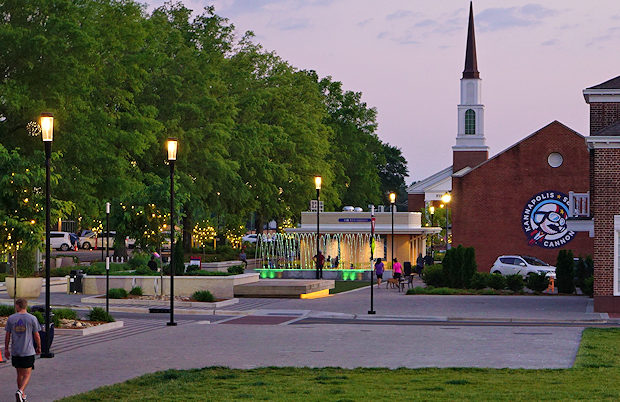
There’s a certain irony that two weeks after Atrium Health Ballpark opened, there was an announcement that the 55-acre property containing Intimidators Stadium had been sold for $3 million to a developer so an industrial park can be built. It will be called Lakeshore Business Park. It’s a great location for that purpose, since it’s near Interstate 85. It just wasn’t a place where restaurants, condos and hotels could ever be built.
Now three miles to the southwest in downtown Kannapolis, development is rising around the new ballpark. But that commercial growth will never push aside the green spaces and city parks.
“We pride ourselves on our recreation,” says Smith. Indeed, Kannapolis has seven traditional municipal parks, with the largest being Village Park, just half a mile from Atrium Health Ballpark. It’s famous for its two-level carousel, the only one of its kind on the East Coast.
And the new ballpark is definitely considered a part of that park system. In fact, it is left unlocked when games aren’t being played so joggers and walkers can use the third-of-a-mile concourse as a track, and kids can use the playground. Doesn’t that leave it open to vandalism? “People feel pride about this park,” says Scotty Brown, the team’s Operating Partner from Temerity Baseball. “They don’t want to deface it or steal anything.”
Sandler points out that “150,000 people used this as a public park before we ever played a game here. What we built has become a very coveted public space for the people of Kannapolis.”
He also is very impressed by the ballpark’s naming-rights sponsor. “I can’t say enough about the role of Cabarrus County’s largest employer — Atrium Health — in financially supporting this endeavor by taking naming rights for the stadium and partnering with Kannapolis Baseball to activate the stadium for use by the community in promoting fitness.”
But why did the city need yet another recreational facility? And on top of that, why did they designate the four-block area adjacent to the stadium a city park?
It’s all about the commercial development that is coming.
Let’s look at exactly where the new ballpark is located. Its outfield fences are along Laureate Way, which makes a 180-degree sweep around an expansive grassy area that if this were a college campus would be referred to as “the commons.” This street features the ballpark, the beautiful building with the city’s services (below, as seen from the left-field area of the ballpark’s exterior) and several of the large research buildings.
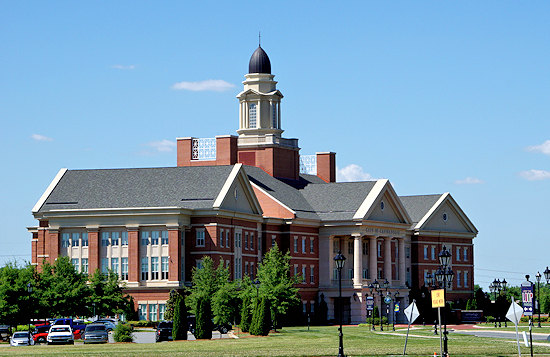
The exact site for the ballpark is wedged into a plot of land between Laureate Way and a previously existing shopping center featuring a Food Lion, Subway and a Family Dollar store. On the west side of the ballpark is a grass lot currently used for parking.
It’s what is currently — and will be — on the east side of the ballpark that is really exciting.
As of this writing, directly east of the park’s right field is a block of older buildings with attractively restored exteriors. Here is the very nice Chophouse 101 restaurant, the aforementioned Gem Theatre with its beautiful art-deco façade, the stately First Baptist Church and refurbished buildings waiting for offices and shops.
As you go south, you’ll find: a coffee shop; two clothing boutiques; James Sweet Spot with candies, board games and puzzles; Old Armor Beer Company, a brewery operated by combat veterans; and Vida Kannapolis, a large apartment complex that is being completed as the ballpark opened. Very importantly, you’ll find Dale Earnhardt Plaza, a small park with a statue of #3 — standing tall, proud and with his arms folded — at its center. When you come to Kannapolis, make sure you visit it.
Now let’s talk about what will be on the east side of the park … and I mean immediately adjacent to the ballpark. As part of the site plan, parcels were graded, sodded and left for exactly what the city leaders envisioned. Says Sandler, “Right along the right-field line along West Avenue, Temerity Baseball and our development partner LMG are putting in a team store, a tavern where we’ll brew Baller Beer which is our own brand, 35 apartments that either look into the stadium or look out on West Avenue, 90 condos, and a Marriott SpringHill Suites hotel. And one block over, we’re putting in another 270 residential units. And all through that streetscape, the first floors will be retail.” Sandler reports that construction will begin on the structure that will house the store, tavern and lofts in September 2021. They expect to break ground on the second phase — the 90 condos — by the end of 2021.
“Part of this is creating a living downtown,” Sandler adds. “We’re leveraging the city’s public investment with several hundred million dollars of private investment. This is the best public-private partnership I’ve ever seen.” Sounds to me like the city’s prediction of $4 of private money for every $1 spent of public money is coming to pass. And then some.
And the goal of creating a place where people will want to live has already come true.
The Exterior
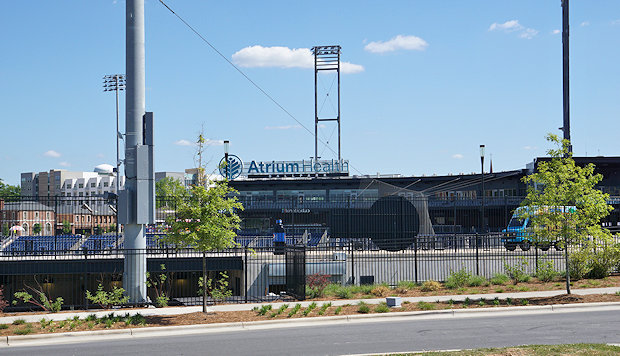
To be honest, the exterior of Atrium Health Ballpark isn’t its strongest feature … but you have to take into account several factors.
 First, from virtually foul pole to foul pole, the iron fencing is meant to be looked through so you can see the interior of the ballpark. The idea is for you to be drawn in and want to buy a ticket for a game.
First, from virtually foul pole to foul pole, the iron fencing is meant to be looked through so you can see the interior of the ballpark. The idea is for you to be drawn in and want to buy a ticket for a game.
Second, near Gate 1 in right field is the graded lots where the condos, hotel, merchandise store and ticket offices will be built. This will greatly change the look of the park, and make it go from feeling wide open to being more cozy and intimate. Right now, the only thing in addition to the cleared lots is the storage container that’s been converted into a temporary box office. And it is all the rage these days to repurpose things like these big storage boxes.
Third, the exterior of the park that is usually where architects like to show off their fancy building materials and striking color schemes and textures — the area behind the main seating bowl — isn’t really meant to be a showplace. Yes, there is a street called Cannon Baller Way that runs all the way between this part of the ballpark and the rear of the Food Lion and the Family Dollar Store, but this is more for deliveries to the stores and the ballpark than where fans line up to enter to see a game. In fact, if you’re walking to the park from downtown parking or, say, the new Vida Kannapolis Apartments, you’d enter Gate 2 behind first base (photo below) before you’d reach this area. Also, cars aren’t allowed on this stretch of Cannon Baller Way while games are going on.
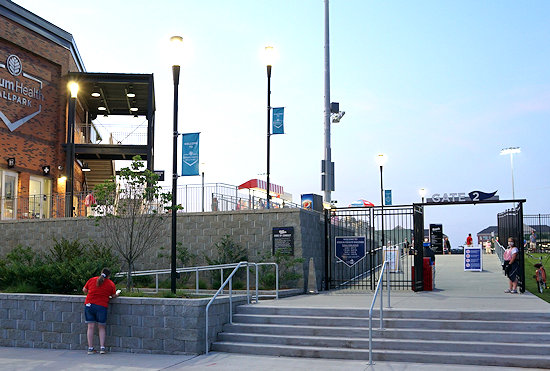
“It would have been very easy to mimic the Georgian look of the buildings on the Research Campus,” Jason Michael Ford, Project Manager from Populous, points out. “The city just didn’t want that.”
Of the four entry gates, Gate 2 is probably the most picturesque, especially since you can see the attractive masonry on the side of the main ballpark structure as you enter. However, that’s not the entryway the team envisioned being the most used. It’s the one in right field. “The ballpark is clearly the destination, but along the way we always intended fans to visit the restaurants and shops along West Avenue,” Ford says. “As the development takes shape, the main ticket office and team store will become an extension of the ballpark. The right-field entry gives you that first glimpse of the playing field and the park-like setting in the middle of the revitalized downtown.”
If you were to walk along the stretch of Cannon Baller Way adjacent to the ballpark’s main structure, you would notice a feature somewhat reminiscent of the ballparks in Rocket City or Hartford, where you can look into the indoor batting tunnels that are under the stands. Unlike Rocket City, you can’t see these tunnels if you’re on the inside of the park.
  |
| The exterior of the ballpark behind the infield isn’t the “showy” area of the facility. It’s pretty utilitarian, with spaces for deliveries and trash pick-up. You can, though, see through windows to check out the indoor batting tunnels. |
If you continue on, you’ll encounter storage spaces for the park and areas where trash pick-up and deliveries can be made. If you continue on up the hill toward Chestnut Avenue, you’ll see no shortage of nice landscaping that sort of surrounds the splash pad and playground that are behind the third-base concourse.
So you won’t find nearly as many things to look at if you walk all the way the exterior as you would, say, at the new park in Wichita, which has tons of art and sculptures at every turn. No, the majority of the construction costs for Kannapolis’ park aren’t tied up in the exterior. Does the interior more than make up for it? And will you have a blast attending a Cannon Ballers’ game? Read on to find out.